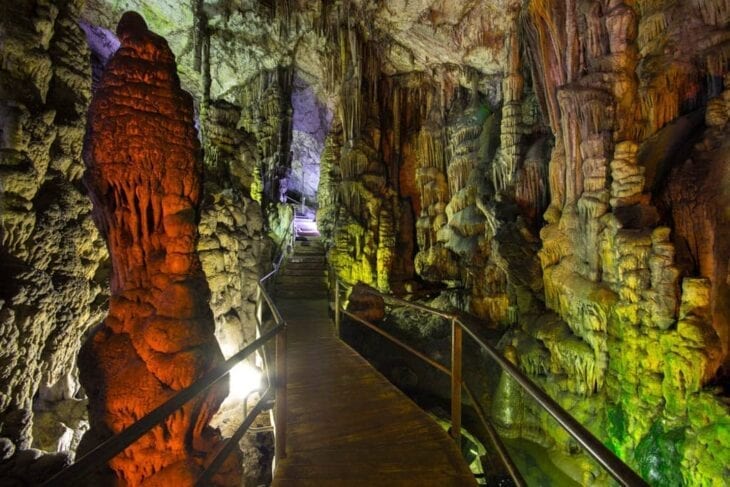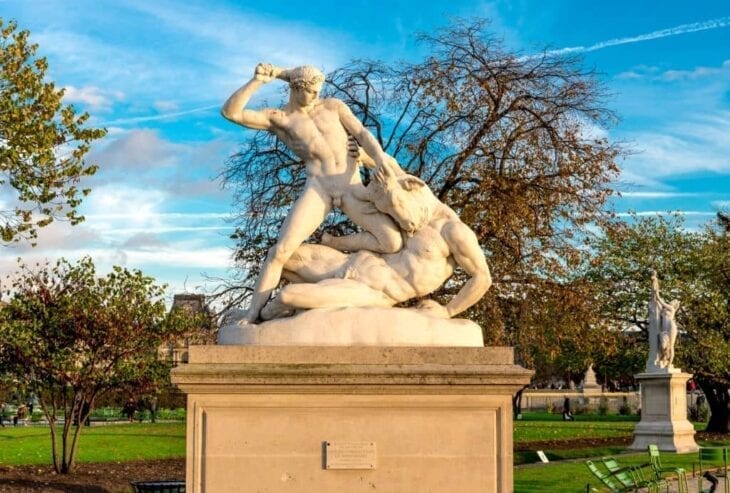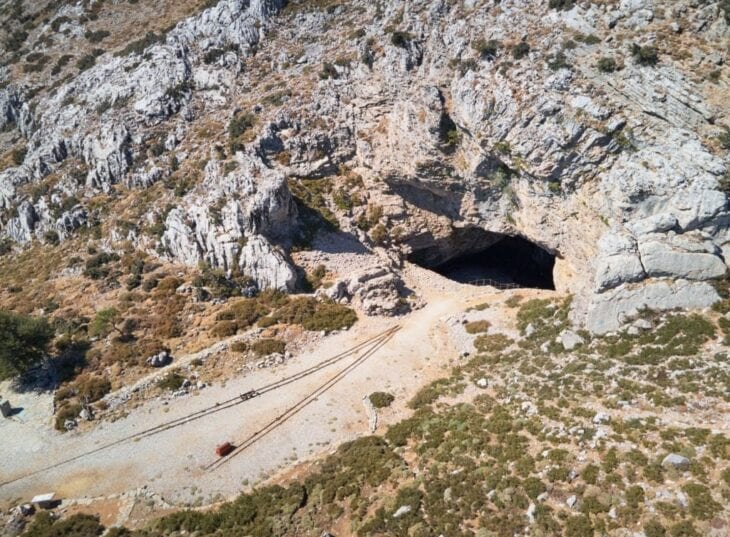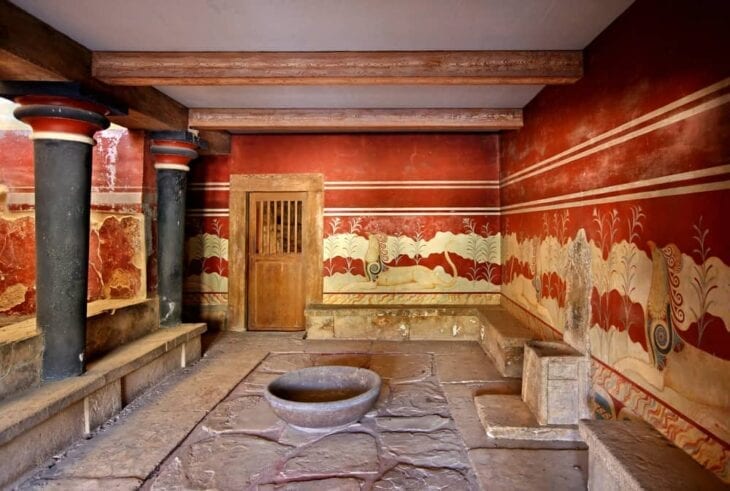Mythology of Crete: Myths and Legends

Crete’s mythology includes accounts of gods, heroes and mythical creatures inhabiting the island. Crete’s tales frequently depict the island’s natural landscapes, including its mountains, caverns and coastline. The ancient Greeks used Crete’s mythology to explain natural phenomena, establish cultural traditions and impart moral teachings.
The origins of Crete in Greek mythology are intricately connected with the stories of many gods and goddesses. Zeus, the king of the gods, was thought to have been born in the Dikteon Cave on the island and played an especially important role. Zeus decided to entice Europa by pretending to be a bull when the king of the gods saw the mortal maiden. Europa gave birth to the legendary Cretan heroes Minos, Rhadamanthus and Sarpedon. The mythical individuals went on to assume leadership positions in Cretan society. Crete had a nurturing and protecting goddess named Rhea, who was the wife of Cronus and the mother of Zeus. They had a significant impact on Cretan culture and mythology, which in turn influenced its history.
King Minos was the ruler of Crete, according to mythology. King Minos was the central figure in the formation and governance of Crete. Minos was the son of Zeus and Europa. King Minos was closely correlated with the myth of the Minotaur, a monster that dwelled in the labyrinth of Knossos. King Minos instituted a sophisticated judicial system with reputed divine assistance. Poseidon even presented Minos with a splendid white bull as a token of favour. The mythology and legends surrounding King Minos’s reign and the King’s ties to the gods are essential.
What is the Mythology of Crete?
Crete has held a mythical allure since ancient times, becoming intertwined with numerous captivating narratives that form the tapestry of Greek mythology. Crete has been woven into the fabric of many captivating tales, revered for its awe-inspiring beauty and enigmatic ambience. The notable myth of Crete, among others, claims it is the birthplace of Zeus, the supreme deity.
Cretan mythology has a certain beauty and aesthetic wealth that has made it popular all over the world. Cretan mythology is the deepest source of the archaeological marvels that one appreciates in various museums and archaeological sites throughout the island. Myths are inextricably linked to actual discoveries on the island.
The birthplace of Zeus is one of the most prominent myths about the island of Crete. The Dikteon Cave was believed to be where Rhea had birthed Zeus, to keep the infant Zeus away from Cronos.

The story of the Minotaur and the Labyrinth is one of the most well-known stories associated with Crete. King Minos of Crete commissioned the construction of a labyrinth to house the Minotaur, a terrible beast with a human body and a bull’s head, according to tradition. The myth emphasises King Minos’ strength and cunning and Theseus’ bravery in venturing inside the labyrinth to slay the Minotaur.
Another important myth is that of Europa, a Phoenician princess who was abducted and brought to Crete by Zeus in the form of a bull. The tale highlights the island’s connection to celestial entities and emphasises its importance as a meeting place for gods and mortals.
Crete’s mythology is vast and varied, including everything from the creation of deities to the stories of great heroes. Crete’s mythology honours the island’s mythological significance and the vital role it played in ancient Greek civilisation.
How was Crete formed according to the Crete Mythology?
Crete was supposedly born through the coupling of Europa, a Phoenician princess and Zeus, king of the gods, in Greek mythology. Zeus, smitten by Europa’s beauty, supposedly took the guise of a white bull to approach the woman stealthily. Europa, taken in by the bull’s amiability, hopped up on its back and Zeus quickly spirited Europa away to Crete.
Zeus revealed the king of gods’ true identity and bestowed upon Europa a variety of gifts, among which was the formidable Talos, upon their arrival on the island. The massive bronze automaton Talos was entrusted with the defence of Europe and Crete. Legend has it that Talos keeps watch over the island, protecting it by throwing stones at passing ships.
Crete’s prominence in Greek mythology is highlighted by the story of Europa and Zeus, which explains the island’s genesis. The island came to represent perfection, prosperity and divine favour. Talos’s legend provides a sense of fortitude and protection to the island’s mythology.

Talos, a mythological guardian figure in Greek mythology, is commonly linked to the island of Crete. The tales say that Zeus gave Talos to Europa to keep the island safe. Talos was a massive bronze robot that patrolled the coast of Crete to ward off invaders.
The Greek myth of Talos is an interesting addition to the legends of Crete, which already picture the island as a fortress blessed by the gods. The Greek myth of Talos further emphasises the mythical ties between Crete and Zeus, Europa and the Greek afterlife, so elevating the island’s status in Greek mythology.
Who are the Gods and Goddesses Involved in the Formation of Crete?
Listed below are the Gods and Goddesses Involved in the Formation of Crete.
- Zeus: The cave on the island that is often referred to as the Cave of Zeus or the Dikteon Cave is where it is believed that Zeus was born. Myth has it that Zeus was brought up on the island of Crete by the nymph Amalthea and guarded by the Curetes, a band of celestial warriors who clashed their weapons to drown out Zeus’s screams and keep the king of the gods concealed from Cronus.
- Rhea: Another significant Cretan deity is Rhea, the mother of Zeus. Zeus was supposedly born to Rhea in the Dikteon Cave and Rhea left the infant Zeus in the care of the nymphs and the Curetes. Crete’s involvement with the birth and upbringing of Zeus is represented by the goddess Rhea.
- Poseidon: The god of the sea, is intimately associated with the island of Crete. Poseidon was responsible for the formation of the island’s landscape by hitting the ground with a trident, which resulted in the formation of springs and rivers. Poseidon was honoured on the island as the guardian of the waters and was frequently linked to the culture of seafaring and nautical pursuits that existed there.
How was Zeus Related to the Dikteon Cave?
Zeus was believed to have been born at Dikteon Cave. Greek mythology believed that Zeus was born in a cave known as the Dikteon Cave (locally known as the Cave of Zeus). The cave was sometimes called the Cave of Zeus. Myth has it that Zeus was born on the island of Crete, more specifically in a cave known as Dikteon Cave, which is found on the Lassithi Plateau.
It is said that when Zeus was a baby, Cronus, Zeus’ father, tried to eat the infant Zeus, but Zeus’ mother, Rhea, hid the child in the cave, making it a holy site and providing infant Zeus with sanctuary from Cronus’ abusive attitude. Zeus was born in the Dikteon Cave and that Zeus’ early life was spent there. The cave holds an important place in the mythology that surrounds the king of the gods, because of such incidents.
Located in the Mount Dicte range on the Greek island of Crete lies the Dikteon Cave, known as the Cave of Zeus. Its convenient location near a number of urban centres means that it attracts guests from all over the region. Neapoli, Malia, Stalida and Hersonissos are some of the cities nearest to the Dikteon Cave. The distance from the cave to these settlements is manageable; but, getting there involves driving up a winding and steep road. Neapoli is a lovely place thanks to its historic centre and proximity to beautiful landscapes. Beautiful beaches and exciting nightlife make Malia and Stalida attractive vacation spots. Water sports and nightlife are major draws to the busy port town of Hersonissos. Travellers from these areas easily arrange a visit to Dikteon Cave to take in its beautiful natural features and learn about its mythological linkages.
Where were Apollo and Artemis Born?
Apollo and Artemis were believed to have been born on a floating island called Delos. A little island known as Delos is found in the Aegean Sea, in close proximity to the bigger island of Mykonos. Leto, their mother, fled to the island of Delos to escape the wrath of Hera, the jealous wife of Zeus. Delos was believed to be a floating island.
Apollo was the god of light, music and prophecy and Artemis was the goddess of the wilderness and the hunt. The event of Apollo and Artemis giving birth on the island of Delos occupies a significant place in Greek mythology and it has been the topic of a wide variety of creative and literary works throughout history. The adoration of the two gods turned the island of Delos into a holy location and it was there that they were honoured.
Apollo and Artemis were born on the island of Delos for a specific reason, according to Greek mythology. The jealous goddess Hera pursued Leto, their mother and tried to stop Leto from giving birth anywhere on Earth. Delos, a small and previously uninhabited island, offered sanctuary to Leto and became the birthplace of the divine twins. Delos was chosen as the birthplace of Apollo and Artemis due to its neutrality and its association with light and purity. The island, which is known today as Paximadia, was considered sacred and free from conflicts or disputes among gods. Paximadia became an ideal location for the birth of such important deities.
Who was the Ruler of Crete, according to mythology?
Minos was a revered figure in Greek mythology who held the esteemed position of king and ruler of the island of Crete. Minos was believed to be the offspring of Zeus and Europa. The legends surrounding Minos depict the god as a significant figure, known for the god’s remarkable achievements. The remarkable achievements include Minos’ ascension to the throne, which was said to have been granted by Poseidon, the god of the sea, and Minos’ role in expanding Crete’s influence by colonising various islands in the Aegean Sea.
Minos is credited with establishing a comprehensive and just code of laws, showcasing the King’s wisdom and governance. Minos emerges as a complex character, sometimes depicted as a fair and just ruler, while in other instances, the King’s reign is portrayed as tyrannical throughout Greek mythology. Scholars and historians have even suggested that “Minos” is a title bestowed upon the rulers of the Bronze Age, further adding to the intrigue and mystery surrounding the enigmatic figure.

What was the Story of Theseus and Ariadne in Crete?
“Theseus and Ariadne on Crete” is a well-known Greek myth that unfolds on the island of Crete. King Minos of Crete demanded a tribute of seven young men and seven young women from Athens every nine years, according to the legend. King Minos of Crete required Athens to send tributes of young men and women to be sacrificed to the Minotaur, a fearsome creature that resided in the labyrinth beneath the Knossos palace. Youths were to be sacrificed to the fearsome Minotaur, a creature with the body of a human and the head of a bull, residing in the labyrinth of Knossos. Theseus, a courageous prince of Athens, volunteered to be one of the sacrificial youths in an attempt to end the cruel tradition.

Theseus captured the attention of Ariadne, the daughter of King Minos, while on Crete. Ariadne fell in love with Theseus and decided to help the prince defeat the Minotaur. Ariadne provided Theseus with a ball of thread, which the Prince used to navigate the labyrinth and find a way back out after slaying the Minotaur.
Theseus and Ariadne fled from Crete together. The journey took a tragic turn when they arrived at the island of Naxos after successfully defeating the Minotaur and escaping the labyrinth. Theseus abandoned Ariadne while the girl was sleeping, leaving Ariadne heartbroken.
Daedalus was crucial to the myths of Crete’s Greek mythology Icarus, the labyrinth maze, Theseus and Ariadne. Daedalus, a Greek mythical craftsman and architect, invented and created the labyrinth. Daedalus built the Crete labyrinth to trap the half-human, half-bull Minotaur. Theseus and the Minotaur revolved around the maze. Ariadne gave Theseus a ball of thread to cross the labyrinth and defeat the Minotaur.

Daedalus created feather-and-wax wings for flying to escape Crete, together with Icarus, the craftsman’s son. Icarus flew dangerously near the sun despite Daedalus’ warning. Icarus then drowned in the sea after the boy’s wings dissolved. The story of Theseus and Ariadne in Crete has become a renowned tale of love, bravery and betrayal despite the bittersweet ending to their relationship. Their story inspired countless artistic works and continues to hold a significant place in Greek mythology and the cultural heritage of Crete.
What are the Famous Caves in Crete?
Listed below are the famous Caves in Crete.
- Dikteon Cave (Psychro Cave): Dikteon Cave, known as the “Cave of Zeus,” is believed to be the birthplace of Zeus, according to Greek mythology. Dikteon Cave is located in the Mount Dicte range and offers impressive stalactite and stalagmite formations.
- Kournas Cave: One of the most stunning caves in Crete’s Chania prefecture is the Cave of Kournas, which is found in the position of Keratides, west of the settlement of Kournas. The journey down to the main hall is long, but once visitors are there, they are captivated by the stunning cave decorations.
- Gerani Cave: The cave of Gerani is widely regarded as one of the most significant and stunning caverns not only in the Rethymno prefecture but even across the entirety of Crete. The cave is found seven kilometres to the west of Rethymnon at a place called “Kamari,” which is near the beach of Gerani. An unexpected discovery of the cave was made on March 15, 1969, while construction workers were putting on a modern highway.
- Agios Antonios Cave at Pastos: The cave of Saint Anthony, locally known as Agios Antonios, is found to the north of the village of Patsos, directly below an impressive rock shelter in the lush green gorge of Patsos, which is sometimes known as the Agios Antonios gorge. Cave of Hermes is another name for the location.
- Sfentoni Cave: Sfentoni Cave is renowned for its unique geological formations and rich biodiversity located near the village of Zoniana. The cave features a well-preserved underground ecosystem with various stalactites, stalagmites and rock formations.
- Labyrinth Cave: Cave Labyrinth is found about 50 kilometres south of Heraklion on a small hill about 3.5 kilometres to the north of the Kastelli settlement in the Messara Plain. Labyrinth Cave was a massive artificial cave with passages that were longer than 2.5 kilometres and various rooms that did not lead anywhere. It was utilised as a quarry for the extraction of stones that were used in the construction of the Minoan palace that was located at Phaestus.
- Melidoni Cave: Melidoni Cave has historical significance as it served as a place of refuge during the Ottoman occupation. It was situated near the village of Melidoni. Melidoni Cave features impressive rock formations and a large chamber that was used as a burial site in ancient times.
- Ideon Andron: Ideon Andron is considered a sacred cave in Greek mythology, located on Mount Ida, the highest mountain range in Crete. Ideon Andron was the hiding place of Zeus during infancy, according to legend. The cave offers breathtaking views of the surrounding landscape.
- Skotino Cave: Skotino Cave is known for its fascinating rock formations and underground chambers, situated near the village of Skotino. Skotino Cave has been inhabited since ancient times and was used as a place of worship during the Minoan period.
- Kamares Cave: The cave of Kamares, which is sometimes referred to as Kamaraiko, is found at the foot of Psiloritis in the south. Kamares Cave is found on the lower slopes of Mount Soros, to be specific, at an elevation of 1700 metres and to the northeast of the village that shares its name, Kamares. The discovery of Minoan artefacts in the cave elevated its status as an important archaeological site, despite the cave’s lack of significance in the field of speleology.

How Does the Crete Mythology Attracted Tourists?
The fascinating history and mythology that surround the island of Crete have always been a compelling selling point for vacationers. The stories told about legendary ancient gods and goddesses, heroic deeds and fantastical creatures generate an atmosphere of mystery and allure that piques the interest of tourists. For instance, visitors become fully submerged in the tales that have been passed down from generation to generation in the Palace of Knossos and the birthplace of Zeus at Dikteon Cave.
The attraction of travelling in the footsteps of mythical figures and seeing the locations that served as inspiration for such tales offers a unique and captivating experience. Crete’s mythology adds a layer of cultural richness to the island, inviting visitors to explore the alluring realm of ancient Greek legends and forge their own personal ties with times gone by.
The promotion of Crete’s mythology through various forms of media, including literature, films and television series, has further popularised the island’s mythical heritage and attracted a wider audience of international tourists. The enduring popularity of Greek mythology as a whole has contributed to the interest in visiting the birthplace of many of such myths.

Does Crete Have Statues of the Mythical Gods and Goddesses?
Yes, Crete has statues of mythical Gods and Goddesses. Two of the most prominent mythological statues in Crete were discovered in the ancient city of Aptera. The statues depict the gods Apollo and Artemis. The statues both stand at around 54 cm and their bases measure around 35 cm. The statue of Artemis is made of copper, while the statue of Apollo is made of marble. These statues were believed to have been imported to Crete and used as decorations for a Roman home.
The Lady of Auxerre is another famous statue from Crete. The limestone statue known as the Lady of Auxerre barely stands approximately 75 centimetres tall, making it quite a miniature work of art. The process of producing the statue incorporates elements from a number of different ancient cultures, although it is believed that it was built on the island of Crete around the year 630 BCE. Many people have differing opinions regarding the objective of the Lady of Auxerre. There is a school of thought that asserts the statue is only symbolic of a young woman or a Greek goddess.
Do Cretan People Believe in Mythology?
Yes, Cretans believe in mythology. The ancient Cretans held a unique belief system regarding the Greek gods, perceiving them as human individuals who attained divine status through their benevolent actions and contributions to humanity. Such a theology emerged from the perspective of mortals rather than being imposed by a higher authority.
Many of the gods, including Zeus, the prominent figure who transitioned from man to deity, were believed to have been born on the island of Crete and were even said to have been buried there according to their beliefs. Such a perspective provided a distinct and localised understanding of the divine realm for the Cretan people.

Last updated on April 10th, 2024














